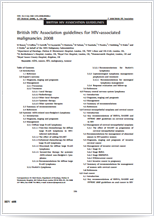 Introduction
Introduction
HIV infection is associated with three AIDS-defining malignancies (Kaposi’s sarcoma, high-grade B-cell non- Hodgkin’s lymphoma and invasive cervical cancer) as well as an increased risk of a number of other malignancies. The clinical care of patients with these tumours requires a multidisciplinary approach drawing on the skills and experience of all healthcare professional groups. Moreover, optimal care can only be achieved by the close cooperation of oncologists, haematologists and HIV physicians, and unless all these clinicians are intimately involved in the care of patients it is likely that the outcome will be less favourable. Patients with HIV-associated malignancies should therefore only be managed in a centre dealing with large numbers of patients with these tumours. An audit study in North London confirmed the better management of patients with AIDS-related lymphoma in HIV centres with cohorts of 4500 patients (level of evidence IV C) [1]. We recommend that all patients with HIV and malignancy should be referred to centres that have developed expertise in the management of these diseases and serve an HIV cohort of 4500. The multidisciplinary medical team managing these patients must include HIV physicians, oncologists, haematologists and palliative care physicians. In line with national cancer waiting times, all patients with suspected cancers must be referred urgently and seen within 2 weeks of referral. Moreover, the NHS Cancer Plan sets out the goal that no patient should wait longer than 1 month from an urgent referral with suspected cancer to the start of treatment. The early chapters of these guidelines consider the three AIDS-defining malignancies, Kaposi’s sarcoma, high-grade non-Hodgkin’s lymphoma (including primary cerebral lymphoma) and cervical cancer. These chapters are followed by chapters on the non-AIDS-defining malignancies including anal cancer, Hodgkin’s lymphoma, multicentric Castleman’s disease and other non-AIDS-defining malignancies, whilst the final chapter discusses the role of antiretroviral therapy and opportunistic infection prophylaxis in the management of malignancy in people with HIV infection.
These guidelines have now been archived. Click here to view the latest version.
Downloads
British HIV Association guidelines for HIV-associated malignancies 2008
Writing Group
Chair
- Professor M Bower (Chelsea and Westminster Hospital, London)
Members
- Mr S Collins (HIV i-Base)
- Dr C Cottrill (St Bartholomew's Hospital, London)
- Dr K Cwynarski (Royal Free Hospital, London)
- Dr S Montoto (St Bartholomew's Hospital, London)
- Dr MR Nelson (Chelsea and Westminster Hospital, London)
- Dr N Nwokolo (Chelsea and Westminster Hospital, London)
- Dr T Powles (St Bartholomew's Hospital, London)
- Dr J Stebbing (Hammersmith Hospital, London)
- Dr N Wales (Chelsea and Westminster Hospital, London)
- Dr A Webb (Royal Sussex County Hospital, Brighton)
Reference
HIV Med, 2008, 9, 681-720



